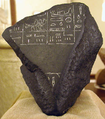| ||
| t (or "feminine") Bread bun "semicircle" in hieroglyphs | ||
|---|---|---|

The ancient Egyptian Bread bun hieroglyph is Gardiner sign listed no. X1 for the side view of a bread bun. It is also the simple shape of a semicircle. The hieroglyph is listed under the Gardiner category of loaves and cakes.
| |
"Bread bun/semi-circle" as feminine determiner
Besides alphabetic-t, the bread bun is used for words that are feminine, as an end qualifying determinant, often shown before other qualifying ideograms or determinants in the hieroglyphic word block-(quadrat hieroglyphic block). It is one of the most frequently used signs in hieroglyphic writing.
Palermo Stone
The t hieroglyph is used extensively throughout the Palermo Stone of the 24th to 23rd century BC, and it is used in the first row (Row I of VI), for the naming of King Tiu of Lower Egypt (a King of the North).
Palermo Stone, King Series, Row I (predynastic)
The following is the list of predynastic pharaohs (Nile Delta north) represented on the Palermo Piece of the 7–piece Palermo Stone: The sequence is in the proper order with the beginning Pharaoh on the right: (reading right-to-left, seven complete names pictured in year-registers):
| |
- Owl...Papyrus...Ripple......Tether...Bread&Feather.Bivalve...Cloth
- Belly.....Fish......Plow........Lake.............Quail.........Newborn...Ka
Note: On the Palermo Stone all the hieroglyphs face in the other direction (Gardiner signs are only facing left; on the stone they face right (reading right-to-left)). The source of the following Pharaohs is only from this King List; a few have artifacts that further confirm their reign (the Double Falcon King). The pharaohs deficient in information are: Hsekiu, Khayu, Tiu (pharaoh), Thesh, Neheb, Wazner, Mekh.
-
Narmer Palette detail, from late 3rd millennium Ancient Egypt
-
Nile River flood levels recorded on 1-piece of the 7—piece Palermo Stone. Note the 2-uses of t.
-
Palermo piece (at Palermo Museum), of the 7—piece Palermo Stone
The Egyptian hieroglyph alphabetic letters
The following two tables show the Egyptian uniliteral signs. (24 letters, but multiple use hieroglyphs)
a
|
y
|
'
|
(w,u)
|
B
| |||||||||||
P
|
M
|
N
|
R
|
H1
| |||||||||||
H2
|
Kh2
|
S
|
(Sh)=Š
|
Q/K2
| |||||||||||
K
|
T
|
Ch—Tj
|
D
|
Dj
| |||||||||||
| L/(R) (special) (Ptolemaic, etc.)
|
-- | -- | -- | -- |
| a | i (ee) |
y ii |
' ah, (aïn) |
w, (u) (oo) |
B | |||||||||||||||||
| P | F | M | N | R | H1 | |||||||||||||||||
| H2 | (Kh)1 | (Kh)2 | S | Sh (Sh) |
K emphatic | |||||||||||||||||
| K | G | T | Tj Ch Tsh |
D | Dj | |||||||||||||||||
| (additionally 4 for vert/horiz) |
-- | -- | -- | -- | -- | |||||||||||||||||
M (horiz) M2-Plinth |
N (vert) (see: N (red crown)) |
S (vert) S (folded) cloth) |
M (3rd-M -2nd-vert) M3-Baker's tool (vertical) | |||||||||||||||||||
| (additionally 3 for equivalents) |
-- | -- | -- | -- | -- | |||||||||||||||||
is—
y2-Two strokes |
is—
letter w, u (see w2-Coil) |
T (no. 2) T2-Pestle |
See also
References
- ^ Schumann-Antelme, and Rossini, 1998. Illustrated Hieroglyphics Handbook, uniliteral: U23, p. 62-63.
Bibliography
- Schumann-Antelme, and Rossini, 1998. Illustrated Hieroglyphics Handbook, Ruth Schumann-Antelme, and Stéphane Rossini. c 1998, English trans. 2002, Sterling Publishing Co. (Index, Summary lists (tables), selected uniliterals, biliterals, and triliterals.) (softcover, ISBN 1-4027-0025-3)



